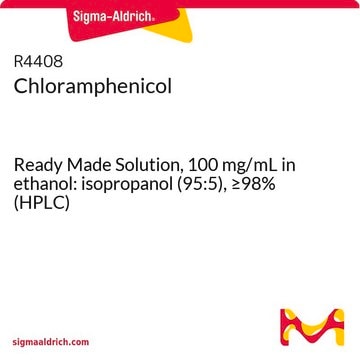31667
Chloramphénicol
VETRANAL®, analytical standard
Synonyme(s) :
D-(−)-thréo-2,2-dichloro-N-[β-hydroxy-α-(hydroxyméthyl)-β-(4-nitrophényl)éthyl]acétamide, D-(−)-threo-2-dichloroacétamido-1-(4-nitrophényl)-1,3-propanediol, D-threo-2,2-dichloro-N-[β-hydroxy-α-(hydroxyméthyl)-4-nitrophenéthyl]acétamide, Chloromycétine
About This Item
Produits recommandés
Qualité
analytical standard
Niveau de qualité
Gamme de produits
VETRANAL®
Pureté
≥98% (HPLC)
Durée de conservation
limited shelf life, expiry date on the label
Technique(s)
HPLC: suitable
gas chromatography (GC): suitable
Pf
149-153 °C (lit.)
Solubilité
H2O: insoluble 100% (practically)
Application(s)
clinical testing
Format
neat
Chaîne SMILES
OC[C@@H](NC(=O)C(Cl)Cl)[C@H](O)c1ccc(cc1)[N+]([O-])=O
InChI
1S/C11H12Cl2N2O5/c12-10(13)11(18)14-8(5-16)9(17)6-1-3-7(4-2-6)15(19)20/h1-4,8-10,16-17H,5H2,(H,14,18)/t8-,9-/m1/s1
Clé InChI
WIIZWVCIJKGZOK-RKDXNWHRSA-N
Vous recherchez des produits similaires ? Visite Guide de comparaison des produits
Description générale
This grade has the standard for Supelco MIP SPE cartridges. For more information request Supelco Literature T407075, T706024
Application
Actions biochimiques/physiologiques
Mode de résistance : La chloramphénicol acétyltransférase acétyle, et donc, inactive le produit.
Spectre antimicrobien : Il s'agit d'un antibiotique à large spectre actif sur les bactéries à Gram positif et les bactéries à Gram négatif principalement destiné à un usage ophtalmologique et vétérinaire.
Attention
Notes préparatoires
Informations légales
Produit(s) apparenté(s)
Mention d'avertissement
Danger
Mentions de danger
Conseils de prudence
Classification des risques
Carc. 2 - Eye Dam. 1 - Repr. 2
Code de la classe de stockage
11 - Combustible Solids
Classe de danger pour l'eau (WGK)
WGK 3
Équipement de protection individuelle
Eyeshields, Gloves, type P3 (EN 143) respirator cartridges
Choose from one of the most recent versions:
Déjà en possession de ce produit ?
Retrouvez la documentation relative aux produits que vous avez récemment achetés dans la Bibliothèque de documents.
Les clients ont également consulté
Notre équipe de scientifiques dispose d'une expérience dans tous les secteurs de la recherche, notamment en sciences de la vie, science des matériaux, synthèse chimique, chromatographie, analyse et dans de nombreux autres domaines..
Contacter notre Service technique










